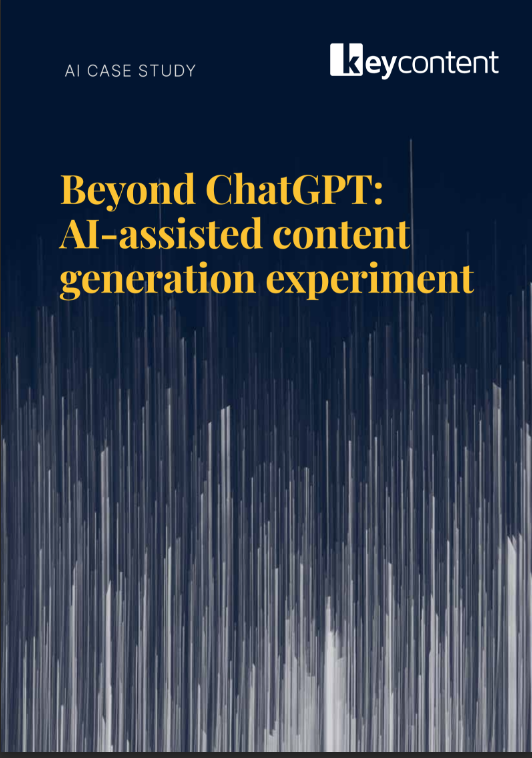What is AI-generated content and how does it work?
At its most basic level, AI-generated content uses artificial intelligence to enable a computer to produce meaningful text about a particular topic, in response to human prompting. An AI content generator trawls through all the information that it has been fed or has otherwise learnt by actively collecting it, and then uses some clever programming to create a readable piece of content.
But what is AI-generated content and how does AI content generation actually work when it comes down to the nuts and bolts? What kinds of technology does it use, and is it truly intelligent or does it still require human input? As more and more of these tools become available, with the consequent production of massive amounts of “machine writing”, let’s have a closer look at what AI-generated content is exactly.
Natural language processing: the cornerstone of AI-generated content
AI content creation depends on the technology of natural language processing. This governs its ability to “understand” human language and interpret it in a similar way to us. To do so, it relies on machine learning algorithms to analyse text and learn without being specifically programmed. It can teach itself, so to speak.
This allows it to gather, analyse and sort information and then produce content in a way that accurately simulates human output. The computer applies machine learning algorithms to analyse vast datasets of information in text form and uses natural language processing to create content that is similar in tone and style to what it has analysed.
Machine learning in AI content writing
Machine learning is essential to AI content creation and forms a crucial part of natural language processing. The technology comprises a set of computational tools that allow computers to analyse and predict without being specifically programmed to do so. This is usually an unsupervised process that requires no human intervention. It’s often referred to as “training AI”.
When further combined with human guidance, it can develop an understanding of contextual semantics, which is how it “learns” the meaning of words. Through millions of repetitions, the machine becomes able to deduce when specific words should be used, based on the patterns it detects among the surrounding words. It doesn’t understand the information per se.
Learning to read and write
Instead, AI relies on context. It can learn the difference between when the word “cloud” is being used in reference to the weather and when it’s being used in computer terms, using the surrounding words to provide clues. Thus it is able to approximate an understanding of context, and when and how to use words. This is also known as “latent semantic indexing”, which is the same way that Google is able to determine the topic of a web page and evaluate the content for ranking purposes.
Natural language processing is used to train the AI generator in this way. The computer is given enormous datasets that can include anything from short articles to books, not to mention having the entire Internet of information at its disposal. Most current AI content generators rely heavily on the Internet to gather information and produce content.
These sources are used to teach the AI generator more detailed nuances of the content it encounters. It can learn the underlying syntax and grammatical rules of the language it is using, and through the use of prompts, can be taught to create content in a precise tone or style, once it has been given examples.
How to detect AI written content
As AI content generators become more sophisticated, it can be difficult to detect on the surface if a published piece has used an AI tool in the writing process. There are some obvious giveaways, such as blatant inaccuracies, clumsy phrasing or semantic non-sequiturs. However, these are easily fixed by a human editor, so they’re becoming less frequent.
But, how to detect AI-written content? The best way to check whether an AI content tool has been used to create a piece of content is to use one of the AI detection tools that have sprung up in the wake of AI-generated content technology.
Learn more about different types of AI-generated content and their pros and cons on our article
Commonly asked questions about AI-generated content
Can Google detect AI content?
Yes, Google can detect AI-generated content. This shouldn’t come as a surprise, given that almost since its inception it has been one of the world leaders in teaching computers to parse and understand text.
So, if you’re wondering how AI content detectors work, Google uses the same natural language processing algorithms to detect the difference between content written by humans and machine-generated content, looking at things like semantic patterns, text structure and syntax. However, as AI generation tools continue to strengthen their capabilities, and with users becoming more adept at their utilisation, the chances of Google penalizing AI-generated content are steadily decreasing.
What are the best AI tools for content writing?
While ChatGPT has taken most of the limelight, there are other prominent AI content generation tools available, depending on the type of content you want to create. For quick and easy template-based AI content, you can use Jasper AI, or choose something like Writesonic for free-form writing. You can also read our guide to AI content tools .
Which is the best free AI content generator?
The best free AI content generator for you depends on your unique capabilities, resources, objectives, and priorities. Factors like your content volume, purpose, platforms used, customisation needs, team collaboration, technical compatibility, and budget all play a role in determining the most suitable tool for you. At Key Content, we are constantly testing different tools to find the best possible solution for our customers’ challenges. Contact us when you need a strategic partner to evaluate your AI-driven content marketing strategy
Are there any AI SEO content generators?
Plenty of AI SEO content generators are available. One of the oldest AI content tools, Kafkai, is specifically dedicated to producing content optimised for search engines. Additionally, RightBlogger emerges as a valuable asset for SEO and keyword research. Jasper, on the other hand, boasts a comprehensive repository of templates, spanning SEO-focused content. Writesonic stands strong with its SEO emphasis and integrations, even encompassing data from Semrush.
Obtaining expert AI-generated content
As always, when you’re getting to grips with the implications and opportunities of new technology, it’s best to speak to those who have already developed expertise in it. Key Content specialises in providing a combination of AI-generated content and information from human writers and subject matter experts. Contact us to discuss your content strategy. We’re here to guide you towards the optimal AI content solution for your business.




